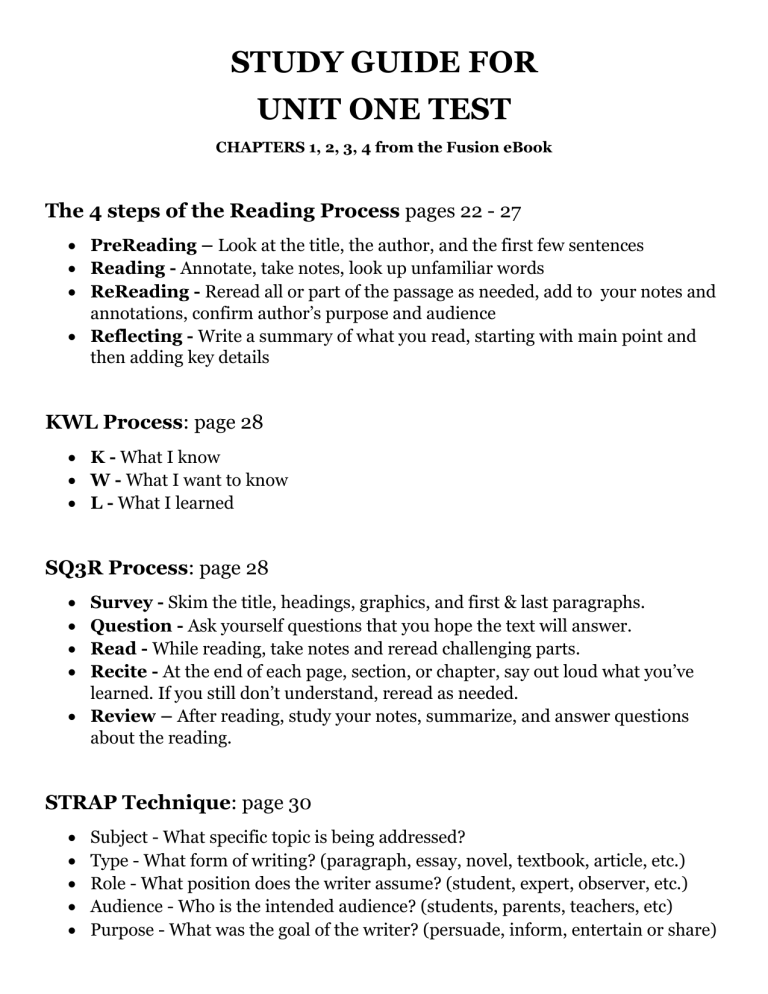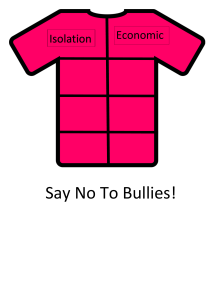
STUDY GUIDE FOR UNIT ONE TEST CHAPTERS 1, 2, 3, 4 from the Fusion eBook The 4 steps of the Reading Process pages 22 - 27 PreReading – Look at the title, the author, and the first few sentences Reading - Annotate, take notes, look up unfamiliar words ReReading - Reread all or part of the passage as needed, add to your notes and annotations, confirm author’s purpose and audience Reflecting - Write a summary of what you read, starting with main point and then adding key details KWL Process: page 28 K - What I know W - What I want to know L - What I learned SQ3R Process: page 28 Survey - Skim the title, headings, graphics, and first & last paragraphs. Question - Ask yourself questions that you hope the text will answer. Read - While reading, take notes and reread challenging parts. Recite - At the end of each page, section, or chapter, say out loud what you’ve learned. If you still don’t understand, reread as needed. Review – After reading, study your notes, summarize, and answer questions about the reading. STRAP Technique: page 30 Subject - What specific topic is being addressed? Type - What form of writing? (paragraph, essay, novel, textbook, article, etc.) Role - What position does the writer assume? (student, expert, observer, etc.) Audience - Who is the intended audience? (students, parents, teachers, etc) Purpose - What was the goal of the writer? (persuade, inform, entertain or share) The 5 steps of the Writing Process pages 30 - 35 Prewriting - This is the 1st and most important step in writing because it involves all the planning before writing the first rough draft. This is where you select a topic, write down what you already know about this topic, conduct research, establish your focus (how do you feel about the topic and how do you plan t0 present your ideas?) Finally, decide what facts to include and in what order you will present them based on your focus. Writing - Write your first draft based on your prewriting. Make sure you have an opening, a middle, and a closing. In the case of the paragraph, this means a topic sentence, a body, and a closing or conclusion. Revising - During this step, you will make changes as needed. Make sure your writing meets the assignment guidelines. Read it silently and then read it aloud to help you identify grammar and punctuation problems. When reading aloud, your paper will not sound smooth if you have made errors. Add, rewrite, cut and reorder as necessary. Editing - This is where you check your revised writing for grammar, punctuation, spelling, and word usage. It is wise to ask a trusted classmate or tutor to check for errors in your writing as well because it can be a challenge to catch everything yourself. Publishing - This is where you prepare your final draft to submit to your instructor. You will need to add a title. Think up something short and catchy that would grab the reader’s interest. Be sure to capitalize the first and last word of your title, nouns, pronouns, adjectives, verbs, adverbs, and subordinating conjunctions. Make “a, an, the” and any prepositions lowercase. Context Clues: pages 67 – 68 Types of Context Clues: 1. Cause-Effect Relationships When one event (cause) makes another event (effect) happen. For example: Asking people to buckle up didn’t work well, so the state made seat belt use mandatory. 2. Definitions within the Text Textbooks often explain or define words within the same sentence to ensure that the reader understands it. For example: Dr. Smith is an anthropologist, a person who scientifically studies the physical, social, and cultural origins of humans. 3. Comparisons and Contrasts When people, places, events, and/or ideas are compared or contrasted. For example: Ruth lives in New York, so she is used to a fast life style; Emmy lives in the country, so she is used to a more serene lifestyle. 4. Words in a Series When 3 or more words, phrases or ideas are used in the same sentence. If one is unfamiliar to you, look at the others to help you identify the new word. For example: Spaghetti, lasagna, and ziti all have their own special shape. 5. Synonyms These words with the same meaning can help you understand a new or challenging word. For example: Jennifer’s essay contained way too many banal, overused phrases. 6. Antonyms These words with opposite meanings can help explain unfamiliar words. For example: My co-worker appeared energetic at first, but looked haggard after 3 hours of hard work. 7. The Tone of the Text This overall feeling or atmosphere which is created in the reading, may help you realize the meaning of the word you aren’t sure of. For example: The street was filled with bellicose protestors who pushed and shoved their way through the crowd. The scene was no longer peaceful and calm, as we had been promised that it would be. ***REMEMBER THIS ABOUT CONTEXT CLUES: To figure out the meaning of a new word, use the words or ideas around it to help you determine the meaning. When choosing an answer on the test, be sure to read the sentence again and see if your choice makes sense! You will need to be able to identify the point and the supporting details from groups of sentences. See page 10 (Ideas) and pages 52 - 54 (Diagrams and Summaries) All writing is built around ideas. As a reader, your goal should be to identify the main idea or point of what you are reading and your goal as a writer is to develop strong ideas in your paragraphs and essays. These traits are very important in communicating your ideas. Main Ideas “What’s the point?” People ask this question when they want to know a speaker or writer’s main idea. Determining the main idea, or point, is the most important key to good comprehension. To find the main idea of a reading selection, ask yourself this question: “What is the point the author is trying to make?” For Example: What is the author’s point in the following paragraph? School bullies have been around as long as there have been schools. Studies reveal several reasons why some children become bullies. Research shows that a certain combination of size and personality may be one factor. Bigger, more aggressive children are more likely to try to dominate their smaller, quieter peers. Another factor linked to bullying is overexposure to violent TV programs. By the time the average American child is ten years old, he or she has watched thousands of acts of violence, including assault and murder. Such exposure can lead to aggression and violence. Finally, exposure to real violence is a factor in bullying. Studies indicate that victims of bullies often turn into bullies themselves. Whether abused by family members or tormented by other kids, bullies typically learn their behavior from others. Look closely into the eyes of a bully, and you may be looking into the eyes of a former victim. Point: Studies reveal several reasons why some children become bullies. Think of the main idea as an “umbrella idea.” The main idea is the author’s general point; all the other material of the paragraph fits under it. This other material is made up of supporting details— specific evidence such as examples, causes, reasons, or facts. Three major supporting details from the above paragraph are: Research shows that a certain combination of size and personality may be one factor. Another factor linked to bullying is overexposure to violent TV programs. Finally, exposure to real violence is a factor in bullying. Three strategies that will help you find the main idea are to 1. Look for general versus specific ideas 2. Use the topic (the general subject of a section) to lead you to the main idea 3. Use key words—verbal clues that lead you to a main idea. A Final Thought: Whether we are readers, writers, listeners, or speakers, the “heart” of clear communication is • the main idea, or point, and • the support for the main idea.


